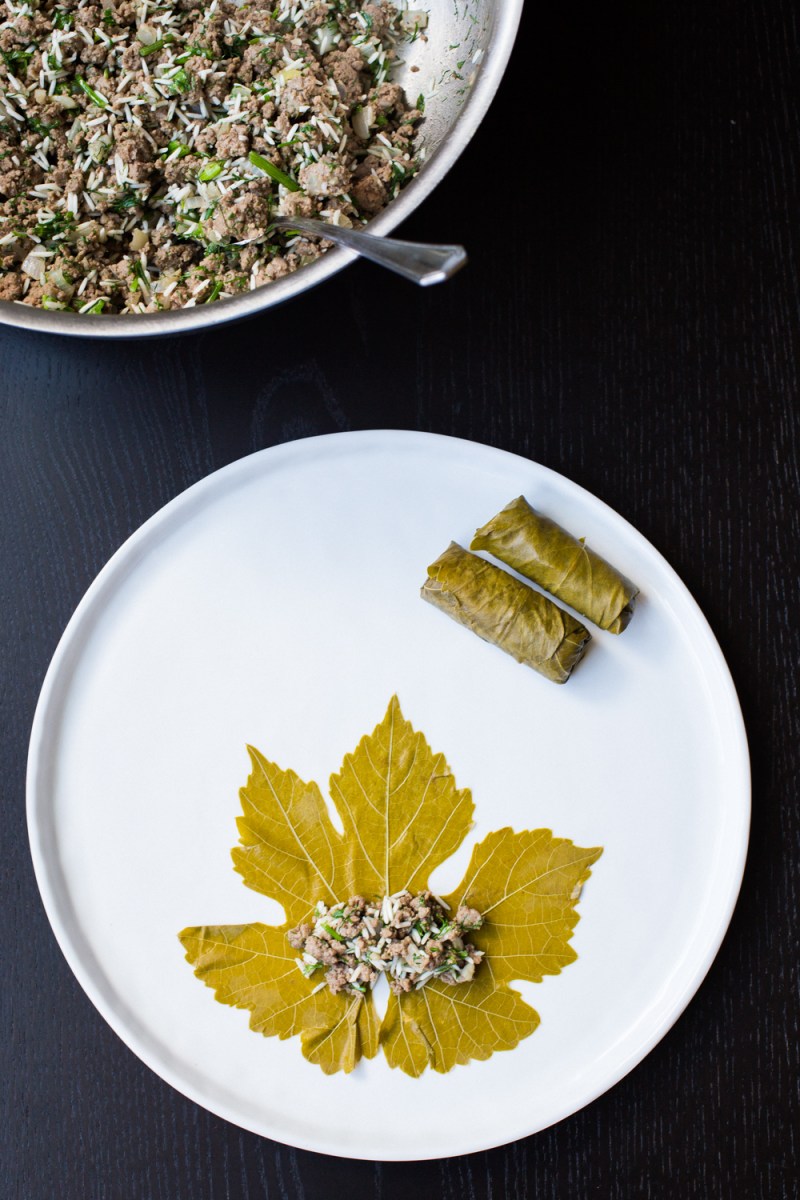
Dolma are stuffed grape leaves, originating in Turkey but expanding all over the Mediterranean, Middle East, and beyond. Their filling can be anything from tomatoes, to eggplant, to meat – really, you can’t go wrong with stuffing these little guys. This particular recipe is the Greek variation, called Dolmathes (an interesting use of Greek plural endings in a foreign word); they are made with rice, ground beef, and fresh herbs. And lemon juice! A whole lemon’s worth. The resulting flavor is both sour, salty, and rich, and is a perfect party dish to accompany other finger foods.
I was first drawn to this dish because it’s a one-stop-macronutrient-shop; it’s equal parts carbs, protein, and fats, ending up in a deeply satisfying experience. The only break from the norm that I adapted in this recipe was to cook the rice in chicken broth instead of water, in order to increase its nutritional profile and tastiness.
Before we move on, let’s have the white rice talk again. As you may know, I find rice to be a perfectly healthy and Paleo-friendly food, since it is very low in toxins (compared to brown rice, and even some common Paleo foods, like coconut). Common questions I get: But what about its glycemic load? Basmati rice (like in this recipe) has a very low glycemic load even compared to other rices, and when paired with protein, fats, and acids, it’s further reduced, and significantly so. But what about arsenic? There are some studies that show there is arsenic in rice, but the amount of arsenic in rice is lower than the arsenic found in other foods (3x less than what’s found in drinking water, for example). But it’s nutritionally poor? Cook it in broth, like in this recipe!
Anyway, those are the most common rice questions I get – be sure to leave more in the comments below if you have any. At the end of the day, I think that white rice is a good thing to have on the table; it’s delicious, and if having a bit of rice as part of a meal helps keep cravings for other (unhealthier) foods at bay, go for it – provided you tolerate it well.
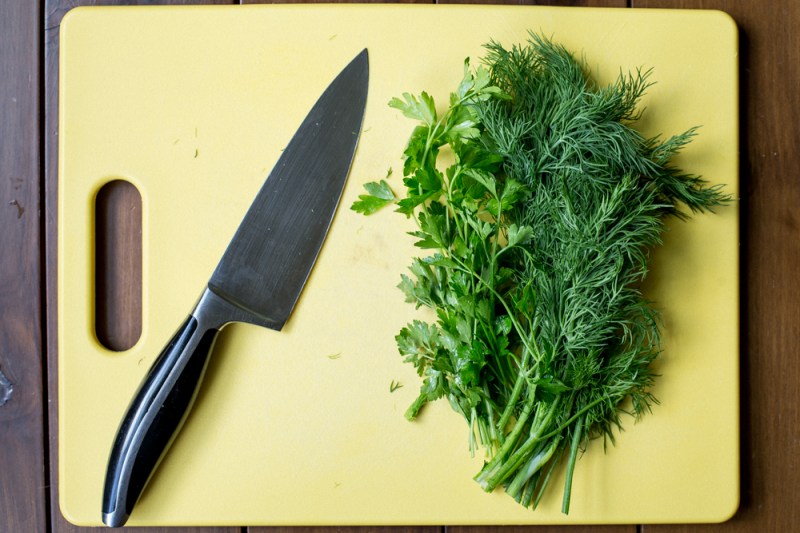
It’s a good idea to use a fairly large amount of fresh herbs, which bring a bright flavor to the rolls when paired with lemon juice.
Dolma (Stuffed Grape Leaves)
1/3 cup white basmati rice, soaked for 30 minutes
1 tbsp olive oil
1 onion, finely chopped
4 cloves garlic, minced
1 lb ground beef
1 small handful fresh dill, chopped
1 small handful fresh parsley, chopped
1 tsp sea salt
1/2 tsp black pepper
1 16oz jar grape leaves (about 50 leaves)
2 tbsp olive oil
juice of one lemon (2 tbsp)
~1 qt chicken broth
lemon slices to garnish
1. Soak the rice in cold water for 30 minutes, then drain. In a skillet, heat the olive oil over medium heat, then add the onion; sauté until softened, stirring often, about 4 minutes. Add the garlic and sauté until fragrant, about 1 minute. Add the ground beef and cook until almost no pink remains, about 6 minutes, then add the drained rice, dill, parsley, salt, and pepper. Sauté for 2 minutes then remove from heat and set aside to cool as you prep the grape leaves.
2. Remove the grape leaves from the jar and gently rinse and dry. Line the bottom of a stockpot with 5 or 6 grape leaves (to prevent the stuffed rolls from sticking to the bottom of the pot).
3. Set one grape leaf in front of you, stem-side facing you and with the veins facing up. Scoop about 1/2 tbsp of the mixture into the center of a leaf (as pictured below), then fold in the sides and tightly roll the rest. Line the stockpot with the rolled leaves, seam-side-down, in a circular pattern; try to use a wide stockpot and make no more than 2 layers (saves on broth). You should have about 40 rolls.
4. Drizzle the olive oil and lemon juice over the rolled leaves, then add enough chicken broth into the stockpot to nearly cover the leaves. Place a heat-resistant plate over the leaves, face-down, to hold them in place. Weight the plate down if you’d like. Cover and bring to a simmer over medium heat (listen for sounds of bubbling), then reduce heat to low and cook until the rice is tender and most of the broth has been absorbed, about 45 minutes. Remove from heat and allow to cool for 10 minutes.
5. Uncover the pot and carefully remove the plate, then use some tongs to gently remove the stuffed grape leaves. Arrange them on a plate; drizzle any remaining broth over the leaves, garnish with lemon slices, and serve.
** Some people like to cool their leaves in the pot overnight in the fridge, in order to help the flavors develop and for the Dolmathes to retain their shape. That’s cool in my book.
** Some Greek recipes call for drizzling an egg-lemon sauce (called Avgolemono) over the grape leaves before serving. To make this sauce, whisk two egg yolks in a bowl until frothy, then whisk in 2 tbsp lemon juice. Heat 1/2 cup of chicken stock in a pan until simmering, then slowly whisk it into the egg/lemon mixture. Return the mixture to your pan and whisk over low heat until it thickens, about 4-5 minutes, then add salt and pepper to taste.
** Feel free to experiment with different fillings; Turkish and Iranian variations of this dish in particular are great, which can include more exotic spices like cumin or saffron.
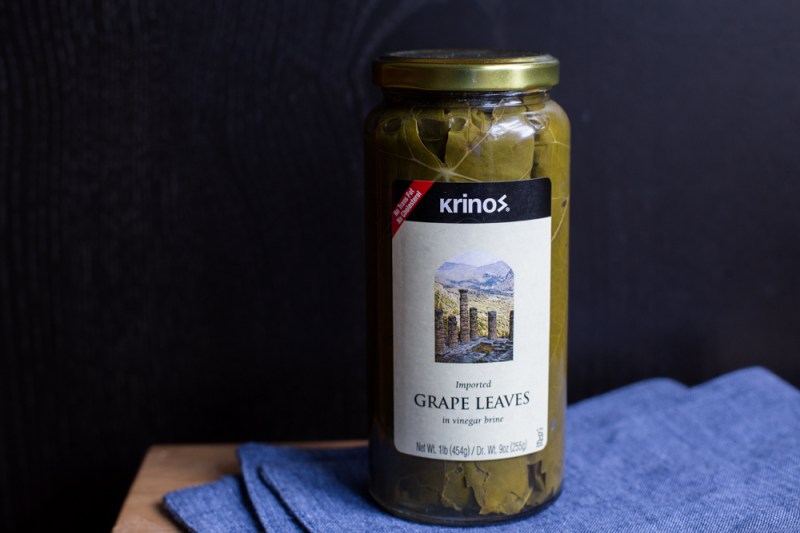
Jarred grape leaves are par-boiled and easy to work with, just remember to rinse the vinegar off the leaves. If you have access to fresh leaves, they work just as well – simply par-boil them for two minutes and run under cool water.
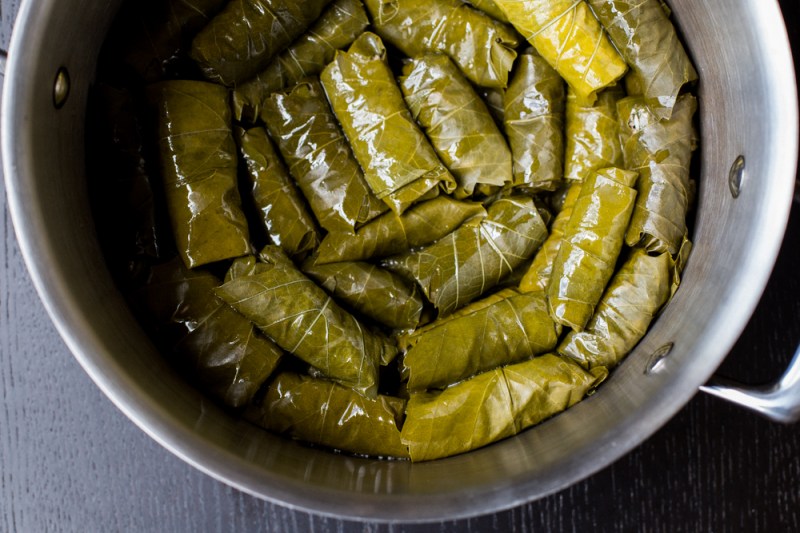
Once you get a good rolling technique down, you can knock this step out pretty quickly – don’t let the idea of rolling a bunch of grape leaves deter you from trying this one out.
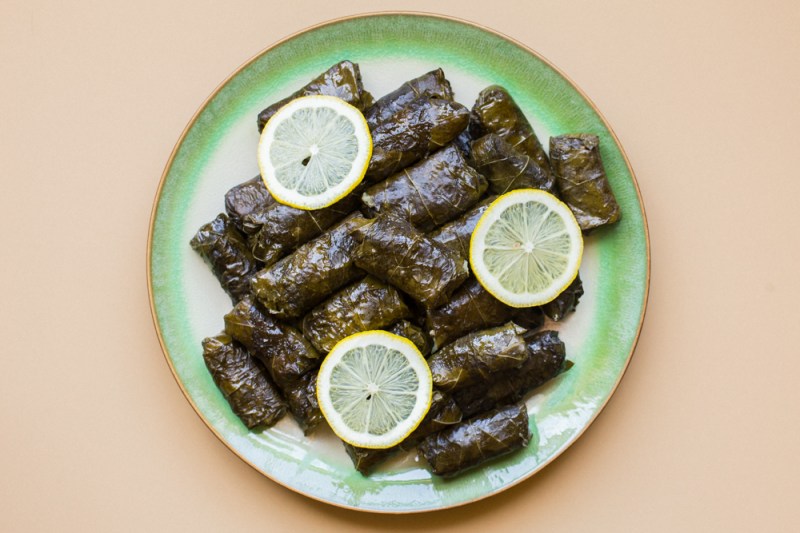

that looks incredibly good!!
LikeLike
Thank you! They tasted pretty good, too :)
LikeLike
I made/cooked meat and rice yesterday for dinner. Can I use the leftovers to stuff the grape leaves? Or does the rice mixture need to be uncooked?
LikeLike
https://www.youtube.com/watch?v=f-I4m6rft5I shows you how to brine your fresh grape leaves.
LikeLike
Oops. Sorry. I posted this comment under the wrong question and do not know how to delete it.
LikeLike
Is it possible to use fresh grape leaves. I have a couple of grape vines that are on our property, planted by the previous owner… The grapes must be for juice or wine, which I’m not interested in, so it would be nice to use the vines for something …
LikeLike
Hi, I included instruction on how to make this with fresh grape leaves under my picture of the jar of grape leaves – long story short, yes they can be used, just par-boil them first! :)
LikeLike
Oops. I accidentally posted a response to you under the post above. Here it is again: https://www.youtube.com/watch?v=f-I4m6rft5I is a link that shows you how to brine your fresh grape leaves to use for stuffing!
LikeLike
I love dolmas! I’ve never tried making them before but would love to give it a whirl. Thanks for sharing!
LikeLike
My pleasure, they’re actually really fun to make, so let me know if you try them.
LikeLike
You got it!
LikeLike
I love them. Ok, tonight I’ll eat greek. Thanks!
LikeLike
Cool!
LikeLike
I can’t wait to try this one, it’s one of my favorite foods and your recipe looks and sounds great.
LikeLike
Thanks Alison! They were definitely a winner.
LikeLike
One of my favourite foods! Thanks for the recipe. :) I’m tempted to mix some ground venison in with that beef.
LikeLike
Jen, any red meat would go great – venison sounds perfect.
LikeLike
Looks amazing! Thank you for the briefing on rice, as well – there was good info I did not know.
LikeLike
Natalie, my pleasure! Glad to hear that you got something from the rice info, I’m often posting about so I never know when I’m preaching to the choir or helping out new readers :)
LikeLike
Thank you for this recipe! I was just thinking that I wanted to make grape leaves, but didn’t know where to get them if not fresh. This is amazing. Yay!
LikeLike
Awesome, happy to be of service!
LikeLike
These look delicious! Wonderful rice tips for making it healthy! :) we love it – especially for ethnic food.
LikeLike
Very cool, glad you liked the rice tips!
LikeLiked by 1 person
Always wanted to try making these. Looks simple enough, I think I’ll give it a go.
LikeLike
Looks great! I’m all about Basmati rice, it’s great for fueling my muscles for swim, bike, running. I’m definitely #TeamRice. It doesn’t make sense for people to avoid rice for it’s glycemic index ranking, especially if they consume paleo-friendly honey and maple syrup. They’re all around the same point in the glycemic index!
LikeLike
Oh my gosh, these looks amazing. I love dolma, really need to try to make it.
LikeLike
Usually meat dolma are served warm and just rice dolma are served cold.
To use fresh grape leaves it’s necessary, besides blanching, that are used very tender leaves picked in the early spring.
I think that Ottolenghi idea, when you are short if time for the rolls, is brilliant! Grape leaves pie: I tried both the lamb meat pie and the yogurt pie. Try it!
LikeLike
Can you clarify what you mean by “toxins” in brown rice and other ‘paleo’ foods? the link goes to a table of phytic acid amounts – if this is what you are referring to, phytate as an anti-nutrient isn’t a “toxin”, the way something like pesticide residue is – and, the methods of soaking beans and grains in an acidulated or lactobacillus active/acid environment ( adding vinegar, whey, live yogurt) to an overnight soak in water ( or adding salt instead to soak nuts) does the job of neutralizing the phytic acid.
LikeLike
Evan, I refer to “toxins” as a catch-all for elements that are disruptive to digestion, including anti-nutrients like phytic acid. I agree that soaking beans and grains is a good way to neutralize most toxins (cooking also eliminates them), but I prefer to focus on white rice because of its ease of use and tastiness. For example, Stephan Guyenet’s method for soaking brown rice (http://wholehealthsource.blogspot.com/2009/04/new-way-to-soak-brown-rice.html), while effective, is likely too involved for our family to sustain, and I don’t expect every reader to make that sort of effort in order to eat rice.
LikeLike
I have been quietly enjoying your blog for some time now. As a confident home cook and photographer I appreciated your enthusiasm for lovely pictures and ethnic fare, but as we both know there are all too many blogs these days that have perfectly photographed recipes that simply don’t work (or aren’t very impressive in practice). That changed when I read your recipe for Eye of Round roast, which I thought was a bit insane, but tried anyway. Delicious! Now I can’t imagine cooking that cut any other way! I love that you included dolma, which I ate frequently growing up. My mom is Lebanese and she used a similar recipe and technique (minus the dill) but always used ground lamb as the meat. You must do a tremendous amount of testing, because your recipes are so workable to follow. I am planning a dinner party in the future and will be using your Moroccan Tagine as one of the dishes. Typically I would test and retest a recipe prior to serving it to guests, but since it’s coming from your blog I know there’s no need. I appreciate your attention to detail and clear/tested instructions.
LikeLike
Hi Mona, thanks for sharing and for your kind words! Let me know what you think of the Tagine when you make it!
LikeLike
This looks so good! I made dolmas a long time ago, but they were always so much work. That said, the payoff was well worth it. Every time I have dolmas at a fast food Greek place I always find myself longing for the homemade version. Yours is an inspiration and your pictures for your other food posts are gorgeous.Your seafood stew looks particularly good!
LikeLike
I have been to Greece and Cyprus many times and they are translated as “Dolmades” (Pronounced like you would pronounce “Martinez”) not “Dolma”…but great recipe! Some purist Greeks do not use ground beef, just fresh mint and rice as the filling. I only had ground lamb and rice filled Dolmades in Cyprus, never in Greece. The Greeks also tend not use ground beef. Greek cuisine is more ‘lamb’ based than beef.
LikeLike
Yes, “Dolma” is the Turkish word and origin of this dish, while “Dolmades” (or “Dolmathes” depending on the Romanization of the Greek cyrillic script) is the Greek variation. Thanks for the insight on how this dish varies in Greece!
LikeLike